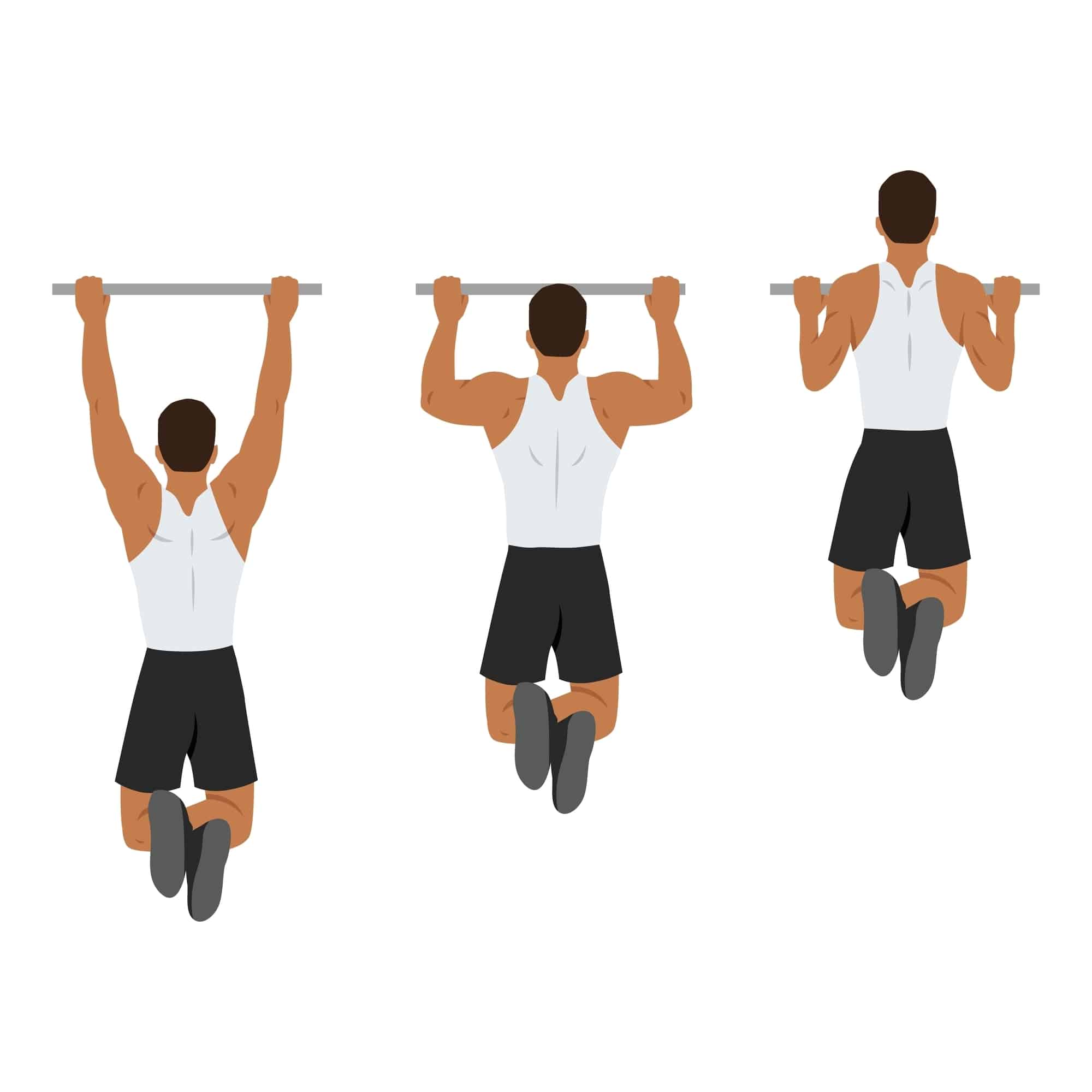Why Are Pull-Ups So Hard?
This guide will help you understand why pull-ups are so hard. Learn to push past sticking points and plateaus to master pull-ups.
Why Do I Suck at Pull-Ups?
Let's say you have a heavy bench, squat, and deadlift.
You're pretty strong, right?
But every time you get on the pull-up bar, it's like you're trying to move against concrete. Your body goes nowhere and you can't even get yourself up for one rep.
For a person who's considered strong, how is this possible?
A lot of training that you do in the gym requires specificity. If you gained all that strength on the bench, squat, and deadlift, it's because you targeted your training toward those goals.
Maybe you've accomplished all of these things but you can't say, do a handstand. Maybe you can't run a marathon either.
How to Train Pull-Ups
Most of us are goal-specific in our training. And just because we may be strong in one area or have a lot of muscle mass, doesn't mean that we're training the skills that it takes to be able to be proficient in another exercise. So every strong guy in the gym is not going to be cranking out reps of pull-ups if he's not training for it.
Want to get good at pull-ups? Train for it. Adapting your training to include high volumes of pull-ups instead of sticking to squats bench presses and deadlifts all the time will help you achieve a more well-rounded type of training. Now, you’re focused on the skill that you want to achieve (the pull-up) so your training will account for this.

Why Do Some People Have an Easier Time with Pull-Ups?
Pull-ups are also often easier not necessarily for later people but sometimes. They can also be simpler for people with very low body fat. To get strong on a bench press you can have a lot of body fat. We often see for example big bulky guys putting up huge numbers on the bench press.
Maybe you could never dream of lifting what they lift on a bench. But you might have more success with a pull-up due to a leaner physique
Neither of these types of strengths are right or wrong provided they're in line with your body and strength goals. They're just different types of strength or different skill training.
Women may also have a more challenging time getting into a proper pull-up due to biology. Because women have lower centers of mass than men, many women find leg-dominant lifts easier.
For example, you may see women absolutely dominating on the leg press or the glute bridge. but often it can be more challenging for women starting on the pull-up bar, even if they are otherwise very athletic, just due to differences in build.
Even if you wouldn't consider your body the ideal one to do pull-ups, pretty much anyone can improve their pull-ups. let's take a look at some tips you can use to start crushing pull-up reps and adding volume to your pull-up routine.
Tips to Do More Pull-Ups
Use a Resistance Band
The reason pull-ups are so hard is that you're working with 100% of your body weight. Compare this to a push-up where you're only using about 60 to 70% of your body weight
Although it doesn't seem like that much more, this is a huge increase in weight. Especially because it's not distributed between your hands and your feet, but is hanging all in your arms and shoulders.
Using a resistance band helps to diminish the amount of weight that you actually lift.
Most commercial gyms will give you access to resistance bands in different sizes and weights.
The weight listed on the resistance band takes approximately that much mass out of your lift.
Say you weigh 150 lb. If you work with a 50 lb resistance band, it will reduce 50 lb from the amount that you're lifting. You would only be lifting about 100 lb of your body weight.
Keep in mind that this amount can vary. It depends on several factors like the elasticity of the band, how you anchor your band to a pull-up bar, and whether you use one or both feet to step on the resistance band. All of these factors can influence how much weight is taken out of your lift, but the listed weight on the resistance band is a good benchmark for how much you'll be lifting.
To do resistance band pull-ups, anchor your band to a pull-up bar. Hook one or both feet into the hanging loop of your resistance band, and grab the bar with an underhand grip to perform assisted pull-ups. Be careful of your footing so you don't slip or lose the band during your lift.

More Sets, Less Reps
If you're trying to work on pull-ups, it can feel like the hardest thing in the world to squeeze out the last rep of your set.
For example, doing five sets of 10 reps is much harder than doing 10 sets of five reps.
Doing sets with a lot of reps leave you leaves you with very little gas in the tank for the last two or three reps. You'll probably end up failing near the end of a set.
Not only can this feel discouraging, it's probably not the most effective way to train. Instead, focus on doing shorter sets with fewer reps where you know you can perform the full set and maybe even have energy left over for one or two more reps.
Let’s say you’re training with sets of five reps and you performed seven sets. For the first seven maybe you had good energy and likely had some juice left over at the end of a set. Now, on your 8th set, you're feeling fatigue setting in around your third rep.
It's okay to fail here since you've already made it through seven complete sets at full rep range.
If you were training with a set of 10 reps, you're probably going to feel yourself feeling quite a bit earlier.
Focus on gradually increasing your sets by maybe one or two reps each time you hit the gym.
Train Pull-Ups More Often than You Think
It seems counterintuitive, but throwing pull-ups in at the end of your gym day no matter what you're training legs push pull upper body, et cetera can actually be a good way to improve your capacity.
On a leg day where you're not touching the upper body at all, it can still benefit you to throw some pull-ups in at the end of your workout. Instead of training them as a primary exercise, see if you can do something like five sets of three perfect reps.
If the next day you're doing cardio, throw this same pull-up rep pattern at the end of your workout as well. All these reps you're getting in throughout the week will build up, even if it's not a priority focus for your day.
Train Your Grip Strength
Part of the difficulty in a pull-up is not only that you have to lift your full body weight, but that you're hanging by your hands the whole time. If you haven't yet accumulated calluses or rougher skin on the hands from regular heavy lifting, this can feel foreign or confusing to your body.
Not only this but it can be a little bit painful. When many new lifters are acclimatizing to the gym and working on gripping rates they might notice torn skin or blisters in the hands from gripping bars. Over time your skin gets stronger and you'll probably be used to having calluses. These are signs of hard work!
But, especially if your hands are getting sweaty with hard work, you may start to fall off your pull-up bar before you’re ready to dismount. Before you try pull-ups, get comfortable with supporting your weight on the bar.
You can do this by practicing dead hangs: where you hang from the pull-up bar without moving your body. the goal is to keep your body fully straight and to be able to support your weight for as long as you can.
To train for a pull-up, do a reverse grip dead hang, with your palms facing backward. See if you can hang from the bar for 1 minute. Dismount and take a 30-second rest, then aim to repeat your dead hang for 2 or 3 more sets. If you do this every day, you'll slowly get more comfortable with supporting your weight.
Strengthen Your Core
Contrary to what you might think, pull-ups are an abdominal move too! Your core keeps your body sturdy and in place while your arms and back are doing the work of lifting you up.
Getting a stronger core will help you tremendously in working on your pull-ups. The dead hand, like we mentioned above is a great way to do this since it focuses on stability.
But you can also try other core stabilizing moves on the floor including things like planks or push-ups. Total body abdominal moves are recommended to get your core nice and sturdy.
Blend your core work and grip training together. Try doing something like a hanging windshield wiper workout to get your abs engaged while you also train your grip. This will help the mind-muscle connection that you need to comfortably support yourself on a hanging pull-up bar while you also perform moves that engage your abs.
The Takeaway
Feeling like you're weak at pull-ups is not unique. Many of us struggle to get our full weight up to the bar.
But be gentle with yourself. Lifting 100% of your body weight is a challenge. It takes targeted training that focuses on pull-ups as a skill.
We often see bodies in the gym that look and perform well in other ways. Maybe that huge hulking powerlifter looks like he should be the strongest guy around, yet you'll see him struggle or fail to do even a few reps on the pull-up bar.
This is because just like you, others in the gym are training for specific skills that they want to master. Just because you have a ton of strength in one domain doesn't mean that it will translate to being able to do perfect pull-ups.
Often people with bulkier bodies or higher body fat compared to their muscle can struggle with pull-ups. Although they may be super strong with heavy lifts like squats or bench presses, pull-ups can be a challenge due to having more mass over all and not training pull-ups as part of their regular routine.
To incorporate pull-ups into your routine and to make this upper-body exercise feel less difficult, there are a few training strategies you can work on:
- Using more but shorter sets
- Adding pull-ups into every training day, no matter what workout you're doing
- Perfecting your technique on assisted pull-ups
- Training your grip strength
- Training complementary lifts that work the relevant muscles, like lat pulldowns, bicep curls, or rows.
Related articles


Get fit with Flex
Build muscle & lose weight fast for free.
Available on iPhone + Apple Watch





